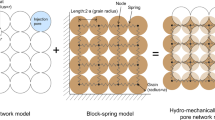Abstract
The technique of micro segmented flow is well applicable for the investigation of soil microorganisms. It supplies highly resolved dose/ response functions for whole microbial communities as well as for single strains. In addition, it can be used in the search for microbial strains with special tolerance features, for example for enhanced concentrations of cobalt and nickel. Such strains have been found in soil samples from the surface of ancient copper mining areas and metal-contaminated soils from archaeological excavations.
Similar content being viewed by others
Literatur
Torsvik V, Sorheim R, Goksoyr J (1996) Total bacterial diversity in soil and sediment communities–a review. J Ind Microbiol 17:170–178
Fierer N, Jackson RB (2006) The diversity and biogeography of soil bacterial communities. Proc Natl Acad Sci USA 103:626–631
Kristiansson E, Fick J, Janzon A et al. (2011) Pyrosequencing of antibiotic-contaminated river sediments reveals high levels of resistance and gene transfer. Plos One 6:e17038
Giller KE, Beare MH, Lavelle P et al. (1997) Agricultural intensification, soil biodiversity and agroecosystem function. Appl Soil Ecol 6:3–16
Prashar P, Kapoor N, Sachdeva S (2014) Rhizosphere: its structure, bacterial diversity and significance. Rev Environ Sci Biotechnol 13:63–77
Riesenfeld CS, Schloss PD, Handelsman J (2004) Metagenomics: genomic analysis of microbial communities. Annu Rev Genet 38:525–552
Torsvik V, Ovreas L (2002) Microbial diversity and function in soil: from genes to ecosystems. Curr Opin Microbiol 5:240–245
Churski K, Kaminski TS, Jakiela S et al. (2012) Rapid screening of antibiotic toxicity in an automated microdroplet system. Lab Chip 12:1629–1637
Cao J, Kürsten D, Schneider S et al. (2012) Uncovering toxicological complexity by multi-dimensional screenings in microsegmented flow: modulation of antibiotic interference by nanoparticles. Lab Chip 12:474–484
Cao J, Köhler JM (2015) Droplet-based microfluidics for microtoxicological studies. Eng Life Sci 15:306–317
Najah M, Valbrix R, Mahendra-Wijaya IP et al. (2014) Droplet-based microfluidics platform for ultra-high-throughput bioprospecting of cellulolytic microorganisms. Chem Biol 21:1722–1732
Garcia-Garcia JD, Sanchez-Thomas R, Moreno-Sanchez R (2016) Bio-recovery of non-essential heavy metals by intraand extracellular mechanisms in free-living microorganisms. Biotechnol Adv 34:859–873
Grodrian A, Metze J, Henkel T et al. (2004) Segmented flow generation by chip reactors for highly parallelized cell cultivation. Biosens Bioelectron 19:1421–1428
Kürsten D, Kothe E, Wetzel K et al. (2014) Micro-segmented flow and multisensor-technology for microbial activity profiling. Environ Sci Process Impacts 16:2362–2370
Author information
Authors and Affiliations
Corresponding author
Additional information
Jialan Cao Jahrgang 1979. Elektrotechnikstudium mit Fachrichtung Biomedizintechnik an der TU Ilmenau; dort 2010–2014 Promotion am Institut für Chemie und Biotechnik. Seit 2015 wissenschaftliche Mitarbeiterin am Fachgebiet Physikalische Chemie/ Mikro reaktions - technik.
J. Michael Köhler Jahrgang 1956. 1976–1981 Chemiestudium an den Universitäten Halle und Jena. Ab 1982 am Physikalisch-Technischen Institut der Akademie der Wissenschaften. Seit 1992 Abteilungsleiter am Institut für Physikalische Hochtechnologie in Jena. Seit 2001 Leiter des Fachgebiets Physikalische Chemie/Mikroreaktionstechnik an der TU Ilmenau.
Tim Schüler Jahrgang 1965. Studium der Physik, Ur- und Frühgeschichte und Klassischen Archäologie an der Universität Jena. 1995 Promotion zum Dr. rer. nat. Seit 1994 wissenschaftlicher Mitarbeiter am Thüringischen Landesamt für Denkmalpflege und Archäologie, derzeit Abteilungsleiter Archäologische Fachaufgaben, Sachgebietsleiter Prospektion und Fachreferent Altsteinzeit sowie kommissarischer Leiter der Restaurierungswerkstatt.
Rights and permissions
About this article
Cite this article
Cao, J., Schüler, T. & Köhler, J.M. Mikrofluidik – großes Potenzial in kleinen Tropfen. Biospektrum 23, 394–397 (2017). https://doi.org/10.1007/s12268-017-0816-2
Published:
Issue Date:
DOI: https://doi.org/10.1007/s12268-017-0816-2




